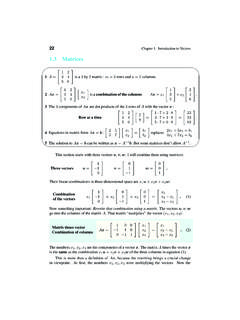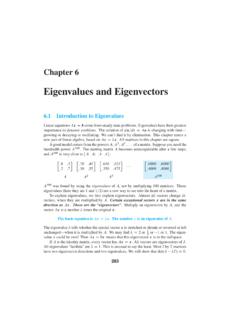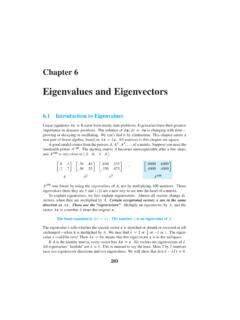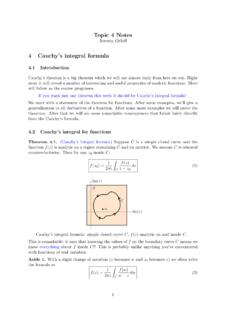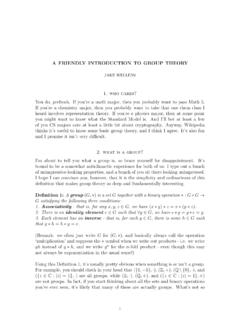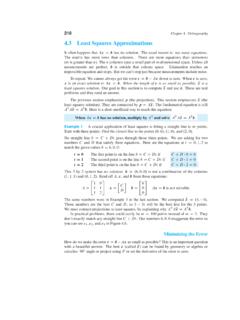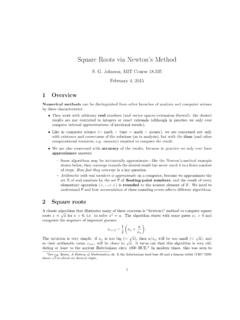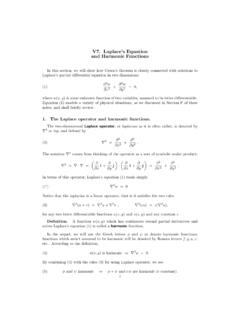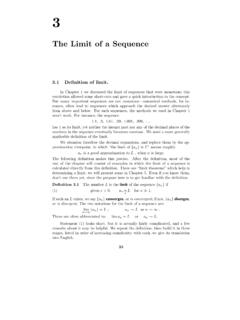Transcription of Chapter 6 Eigenvalues and Eigenvectors
1 Chapter 6 Eigenvalues and Introduction to Eigenvalues '&$%1 Aneigenvectorxlies along the same line asAx:Ax= .2 IfAx= xthenA2x= 2xandA 1x= 1xand(A+cI)x= ( +c)x: the xthen(A I)x=0andA Iis singular anddet(A I)= s bydetA= ( 1)( 2) ( n)and diagonal suma11+a22+ +ann=sum of have =1and0. Reflections have1and 1. Rotations haveei ande i :complex!This Chapter enters a new part of linear algebra . The first part was aboutAx=b:balance and equilibrium and steady state. Now the second part is aboutchange. Timeenters the picture continuous time in a differential equationdu/dt=Auor time stepsin a difference equationuk+1=Auk.
2 Those equations are NOT solved by key idea is to avoid all the complications presented by the matrixA. Supposethe solution vectoru(t)stays in the direction of a fixed vectorx. Then we only need tofind the number (changing with time) that multipliesx. A number is easier than a want Eigenvectors xthat don t change direction when you multiply good model comes from the powersA, A2, A3, ..of a matrix. Suppose you needthe hundredth powerA100. Its columns are very close to theeigenvector(.6, .4):A, A2, A3=.
3 A100 . A100was found by using theeigenvaluesofA, not by multiplying 100 matrices. Thoseeigenvalues (here they are = 1and1/2) are a new way to see into the heart of a Introduction to Eigenvalues289To explain Eigenvalues , we first explain Eigenvectors . Almost all vectors change di-rection, when they are multiplied exceptional vectorsxare in the samedirection are the Eigenvectors . Multiply an eigenvector byA, and thevectorAxis a number times the basic equation isAx= number is an eigenvalue eigenvalue tells whether the special vectorxis stretched or shrunk or reversed or leftunchanged when it is multiplied byA.
4 We may find = 2or12or 1or1. The eigen-value could be zero! ThenAx= 0xmeans that this eigenvectorxis in the the identity matrix, every vector hasAx=x. All vectors are Eigenvectors Eigenvalues lambda are = 1. This is unusual to say the least. Most2by2matriceshavetwoeigenvector directions andtwoeigenvalues. We will show thatdet(A I) = section will explain how to compute thex s and s. It can come early in the coursebecause we only need the determinant of a2by2matrix. Let me usedet(A I) = 0tofind the Eigenvalues for this first example, and then derive itproperly in equation (3).
5 Example 1 The matrixAhas two Eigenvalues = 1and = 1/2. Look atdet(A I):A= . det .8 . = 2 32 +12= ( 1) 12 .I factored the quadratic into 1times 12, to see the two Eigenvalues =1and =12. For those numbers, the matrixA Ibecomessingular(zero determinant). Theeigenvectorsx1andx2are in the nullspaces ofA IandA 12I.(A I)x1= 0isAx1=x1and the first eigenvector is(.6,.4).(A 12I)x2= 0isAx2=12x2and the second eigenvector is(1, 1):x1= . andAx1= .. =x1(Ax=xmeans that 1= 1)x2= 1 1 andAx2= . 1 1 = .5 .5 (this is12x2so 2=12).
6 Ifx1is multiplied again byA, we still getx1. Every power ofAwill giveAnx1= , and if we multiply again we get(12) squared, the Eigenvectors stay the same. The eigenvaluesare pattern keeps going, because the Eigenvectors stay in their own directions (Figure )and never get mixed. The Eigenvectors ofA100are the samex1andx2. The eigenvaluesofA100are1100= 1and(12)100=very small vectors do change direction. But all other vectors arecombinations of the twoeigenvectors. The first column ofAis the combinationx1+ (.2)x2:Separate into eigenvectorsThen multiply byA.
7 =x1+ (.2)x2= . + .2 .2 .(1)290 Chapter 6. Eigenvalues and EigenvectorsFigure : The Eigenvectors keep their 2xwith 2= 12and(.5) we multiply separately forx1and(.2)x2,Amultipliesx2by its eigenvalue12:Multiply eachxiby iA . isx1+12(.2)x2= . + .1 .1 = ..Each eigenvector is multiplied by its eigenvalue , when we multiply byA. At every stepx1is unchanged andx2is multiplied by 12 , so99steps give the small number 12 99:A99 . is reallyx1+ (.2) 12 99x2= . + verysmallvector .This is the first column ofA100. The number we originally wrote not left out(.)
8 2)(12)99which wouldn t show up for30decimal eigenvectorx1is a steady state that doesn t change (because 1= 1). Theeigenvectorx2is a decaying mode that virtually disappears (because 2=.5). Thehigher the power ofA, the more closely its columns approach the steady particularAis aMarkov matrix. Its largest eigenvalue is = 1. Its eigenvectorx1= (.6, .4)is thesteady state which all columns ofAkwill approach. Section how Markov matrices appear when you search with projection matricesP, we can see whenP xis parallel tox.
9 The eigenvectorsfor = 1and = 0fill the column space and nullspace. The column space doesn tmove(Px=x). The nullspace goes to zero(Px= 0x). Introduction to Eigenvalues291 Example 2 The projection matrixP= . has Eigenvalues = 1and = Eigenvectors arex1= (1,1)andx2= (1, 1). For those vectors,Px1=x1(steadystate) andPx2=0(nullspace). This example illustrates Markov matrices andsingularmatrices and (most important) symmetric matrices. All havespecial s andx s:1. Markov matrix: Each column ofPadds to1, so = 1is an , so = 0is an , so its Eigenvectors (1,1)and(1, 1)are only Eigenvalues of a projection matrix are0and1.
10 The Eigenvectors for = 0(whichmeansPx= 0x)fill up the nullspace. The Eigenvectors for = 1(which meansPx=x)fill up the column space. The nullspace is projected to zero. The column space projectsonto itself. The projection keeps the column space and destroys the nullspace:Project each partv= 1 1 + 22 projects ontoPv= 00 + 22 .Projections have = 0and 1. Permutations have all| |= 1. The next matrixRis areflection and at the same time a has special 3 The reflection matrixR= 0 11 0 has eigenvalues1and eigenvector(1,1)is unchanged byR.
